Transport of a Micro Liquid Plug in a Gas-Phase Flow in a Microchannel
Abstract
:1. Introduction
2. Experimental Section
3. Results and Discussion
3.1. Behavior of Micro Liquid Plug in Microchannel
3.2. Velocity of Accelerated Micro Liquid Plug
3.3. Split of Accelerated Micro Liquid Plug
4. Conclusions
Supplementary Materials
Author Contributions
Funding
Conflicts of Interest
References
- Janasek, D.; Franzke, J.; Manz, A. Scaling and the design of miniaturized chemical-analysis systems. Nature 2006, 442, 374–380. [Google Scholar] [CrossRef] [PubMed]
- Mawatari, K.; Kazoe, Y.; Aota, A.; Tsukahara, T.; Sato, K.; Kitamori, T. Microflow systems for chemical synthesis and analysis: Approaches to full integration of chemical process. J. Flow Chem. 2011, 1, 3–12. [Google Scholar] [CrossRef]
- Tokeshi, M.; Minagawa, T.; Uchiyama, K.; Hibara, A.; Sato, K.; Hisamoto, H.; Kitamori, T. Continuous-flow chemical processing on a microchip by combining microunit operations and a multiphase flow network. Anal. Chem. 2002, 74, 1565–1571. [Google Scholar] [CrossRef] [PubMed]
- Guo, M.T.; Rotem, A.; Heyman, A.; Weitz, D.A. Droplet microfluidics for high-throughput biological assays. Lab Chip 2012, 12, 2146–2155. [Google Scholar] [CrossRef] [PubMed]
- Günther, A.; Khan, S.A.; Thalmann, M.; Trachsel, F.; Jensen, K.F. Transport and reaction in microscale segmented gas-liquid flow. Lab Chip 2004, 4, 278–286. [Google Scholar] [CrossRef] [PubMed]
- Adamson, D.N.; Mustafi, D.; Zhang, J.X.J.; Zheng, B.; Ismagilov, R.F. Production of arrays of chemically distinct nanoliter plugs via repeated splitting in microfluidic devices. Lab Chip 2006, 6, 1178–1186. [Google Scholar] [CrossRef] [PubMed]
- Günther, A.; Jensen, K.F. Multiphase microfluidics: From flow characteristics to chemical and material synthesis. Lab Chip 2006, 6, 1487–1503. [Google Scholar] [CrossRef] [PubMed]
- Günther, A.; Jhunjhunwala, M.; Thalmann, M.; Schmidt, M.A.; Jensen, K.F. Micromixing of miscible liquids in segmented gas-liquid flow. Langmuir 2006, 21, 1547–1555. [Google Scholar] [CrossRef] [PubMed]
- Khan, S.A.; Günther, A.; Schmidt, M.A.; Jensen, K.F. Microfluidic synthesis of colloidal silica. Langmuir 2004, 20, 8604–8611. [Google Scholar] [CrossRef] [PubMed]
- Larrea, A.; Sebastian, V.; Ibarra, A.; Arruebo, M.; Santamaria, J. Gas slug microfluidics: A unique tool for ultrafast, highly controlled growth of iron oxide nanostructures. Chem. Mater. 2015, 27, 4254–4260. [Google Scholar] [CrossRef] [PubMed]
- Yen, B.K.H.; Günther, A.; Schmidt, M.A.; Jensen, K.F.; Bawendi, M.G. A Microfabricated gas-liquid segmented flow reactor for high-temperature synthesis: The case of CdSe quantum dots. Angew. Chem. Int. Ed. 2005, 44, 5447–5451. [Google Scholar] [CrossRef] [PubMed]
- Cabeza, V.S.; Kuhn, S.; Kulkarni, A.A.; Jensen, K.F. Size-controlled flow synthesis of gold nanoparticles using a segmented flow microfluidic platform. Langmuir 2012, 28, 7007–7013. [Google Scholar] [CrossRef] [PubMed]
- Walsh, P.A.; Walsh, E.J.; Muzychka, Y.S. Heat transfer model for gas-liquid slug flows under constant flux. Int. J. Heat Mass Trans. 2010, 53, 3193–3201. [Google Scholar] [CrossRef]
- Takahashi, K.; Mawatari, K.; Sugii, Y.; Hibara, A.; Kitamori, T. Development of a micro droplet collider; the liquid-liquid system utilizing the spatial-temporal localized energy. Microfluid. Nanofluid. 2010, 9, 945–953. [Google Scholar] [CrossRef]
- Takahashi, K.; Sugii, Y.; Mawatari, K.; Kitamori, T. Experimental investigation of droplet acceleration and collision in the gas phase in a microchannel. Lab Chip 2011, 11, 3098–3105. [Google Scholar] [CrossRef] [PubMed]
- Kazoe, Y.; Yamashiro, I.; Mawatari, K.; Kitamori, T. High-pressure acceleration of nanoliter droplets in the gas phase in a microchannel. Micromachines 2016, 7, 142. [Google Scholar] [CrossRef]
- Takei, G.; Nonogi, M.; Hibara, A.; Kitamori, T.; Kim, H.-B. Tuning microchannel wettability and fabrication of multi-step Laplace valves. Lab Chip 2007, 7, 596–602. [Google Scholar] [CrossRef] [PubMed]
- Ishibashi, R.; Mawatari, K.; Takahashi, K.; Kitamori, T. Development of a pressure-driven injection system for precisely time controlled attoliter sample injection into extended nanochannels. J. Chromatogr. A 2012, 1228, 51–56. [Google Scholar] [CrossRef] [PubMed]
- Hibara, A.; Iwayama, S.; Matsuoka, S.; Ueno, M.; Kikutani, Y.; Tokeshi, M.; Kitamori, T. Surface modification method of microchannels for gas-liquid two-phase flow in microchips. Anal. Chem. 2005, 77, 943–947. [Google Scholar] [CrossRef] [PubMed]
- Kinoshita, H.; Kaneda, S.; Fujii, T.; Oshima, M. Three-dimensional measurement and visualization of internal flow of a moving droplet using confocal micro-PIV. Lab Chip 2007, 7, 338–346. [Google Scholar] [CrossRef] [PubMed]
- Kreutzer, M.T.; Kapteijn, F.; Moulijn, J.A.; Heiszwolf, J.J. Multiphase monolith reactors: Chemical reaction engineering of segmented flow in microchannels. Chem. Eng. Sci. 2005, 60, 5895–5916. [Google Scholar] [CrossRef]
- Kreutzer, M.T.; Trachsel, F.; von Rohr, P.R. Segmented gas-liquid flow characterization in rectangular microchannels. Int. J. Multiph. Flow 2008, 34, 1108–1118. [Google Scholar] [CrossRef]
- Hosokawa, K.; Fujii, T.; Endo, I. Handling of picoliter liquid samples in a poly(dimethylsiloxane)-based microfluidics device. Anal. Chem. 1999, 71, 4781–4785. [Google Scholar] [CrossRef]
- Yamada, M.; Seki, M. Nanoliter-sized liquid dispenser array for multiple biochemical analysis in microfluidic devices. Anal. Chem. 2004, 76, 895–899. [Google Scholar] [CrossRef] [PubMed]

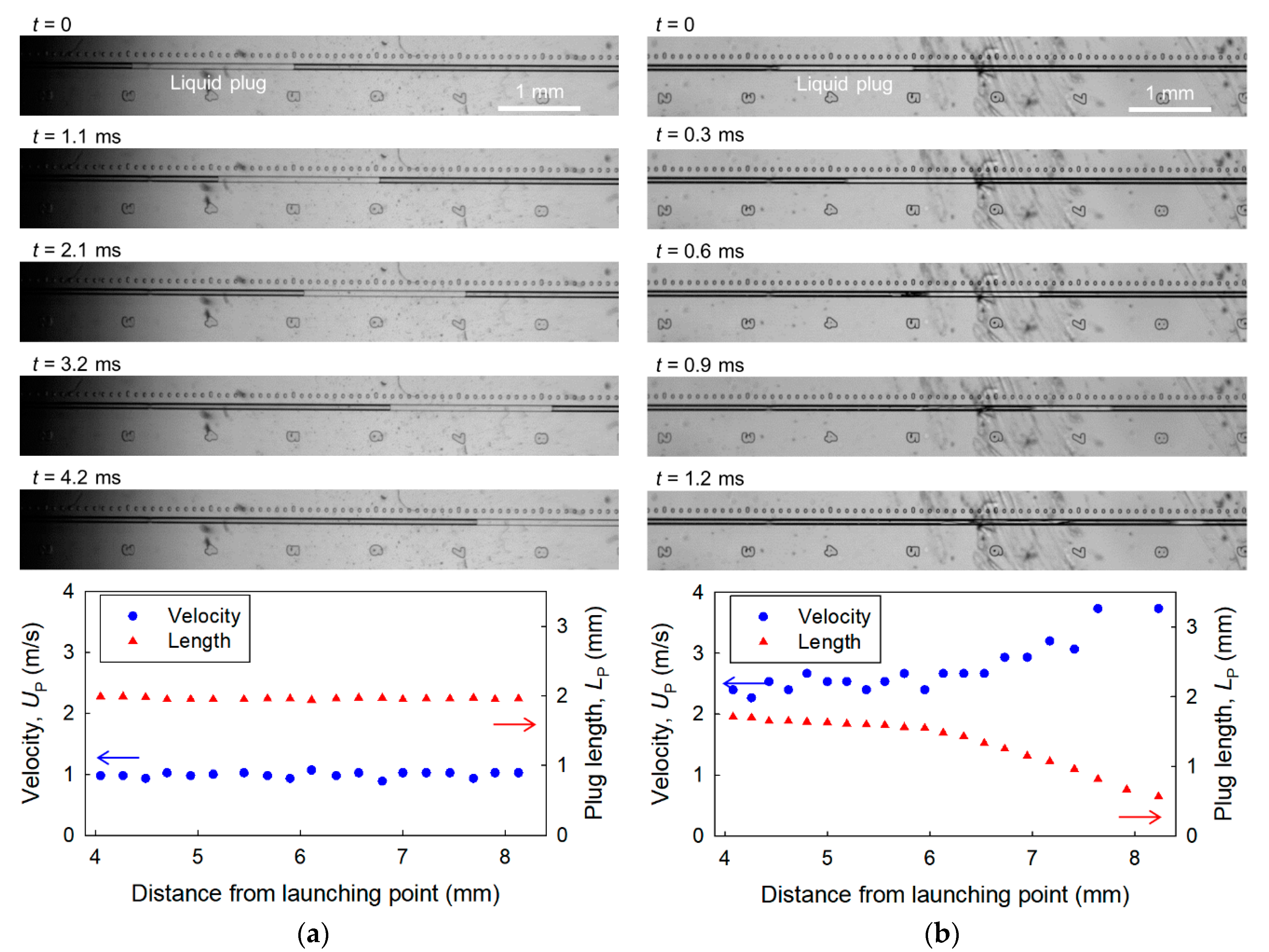
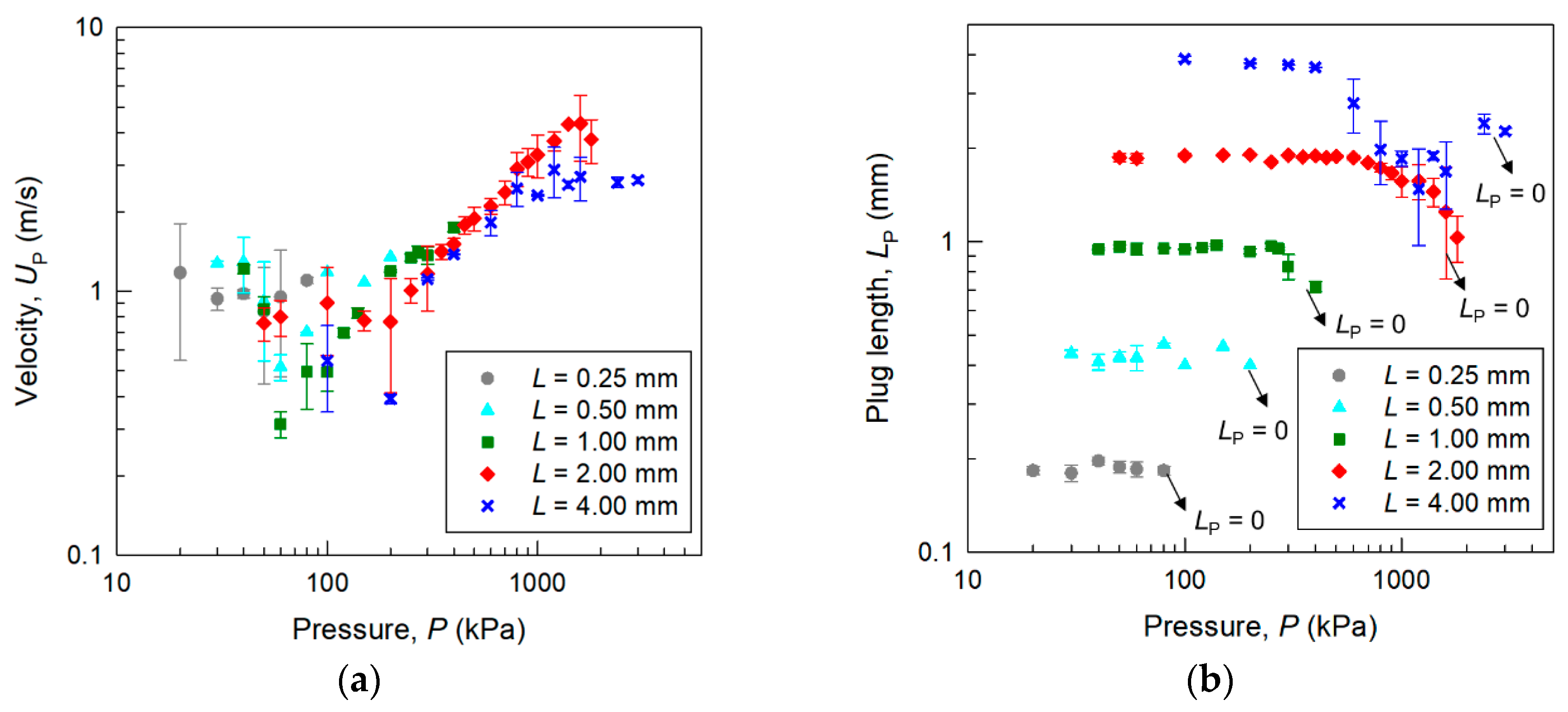
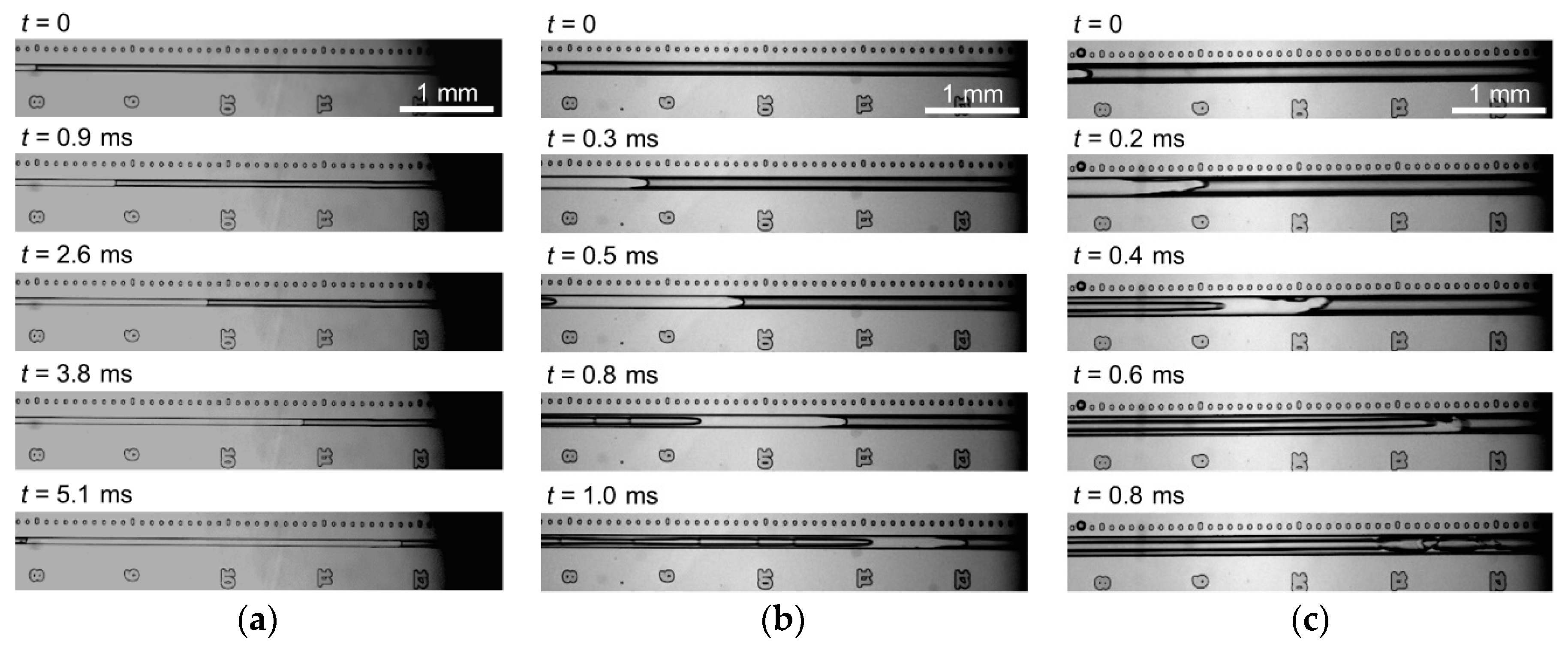
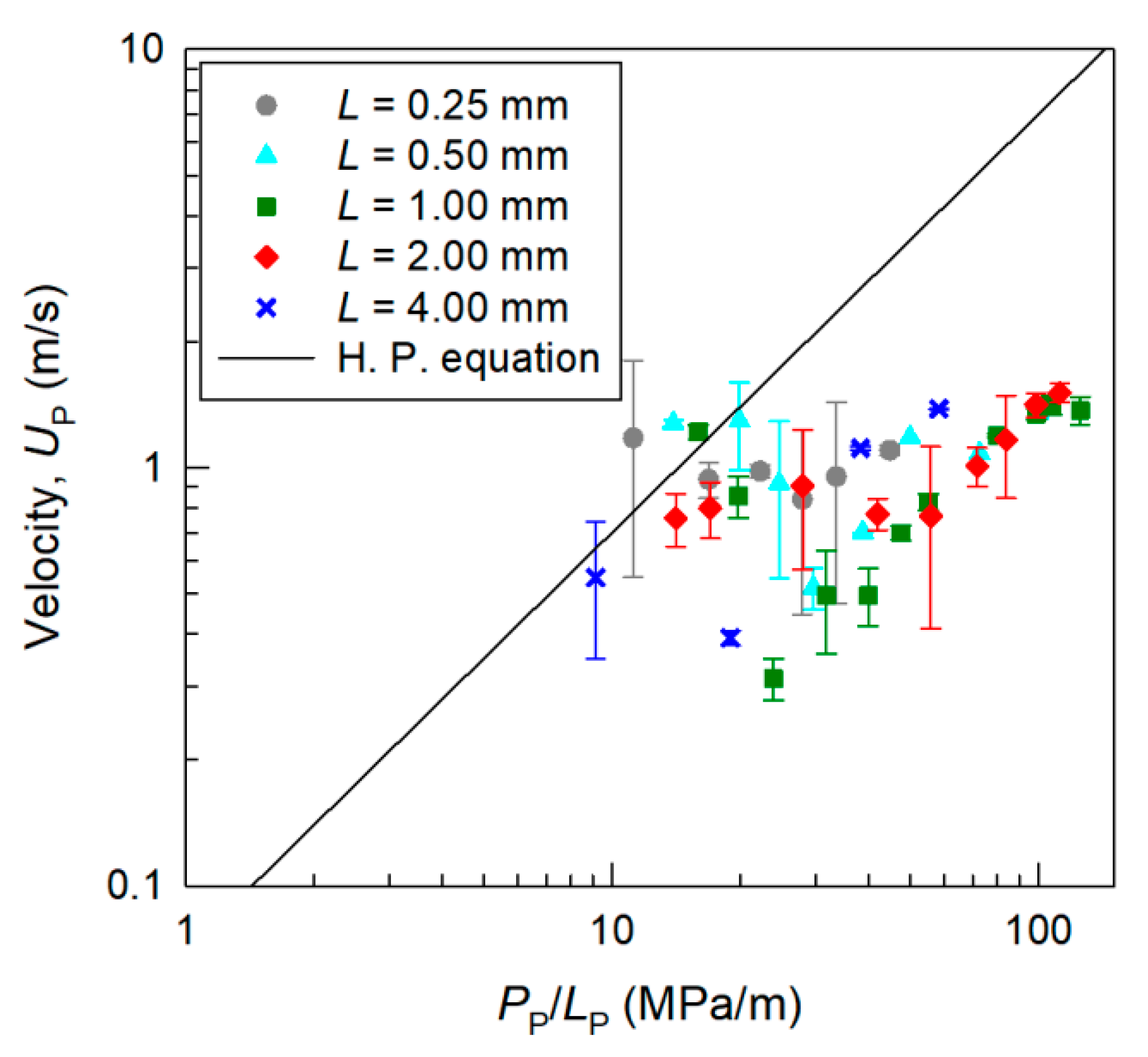
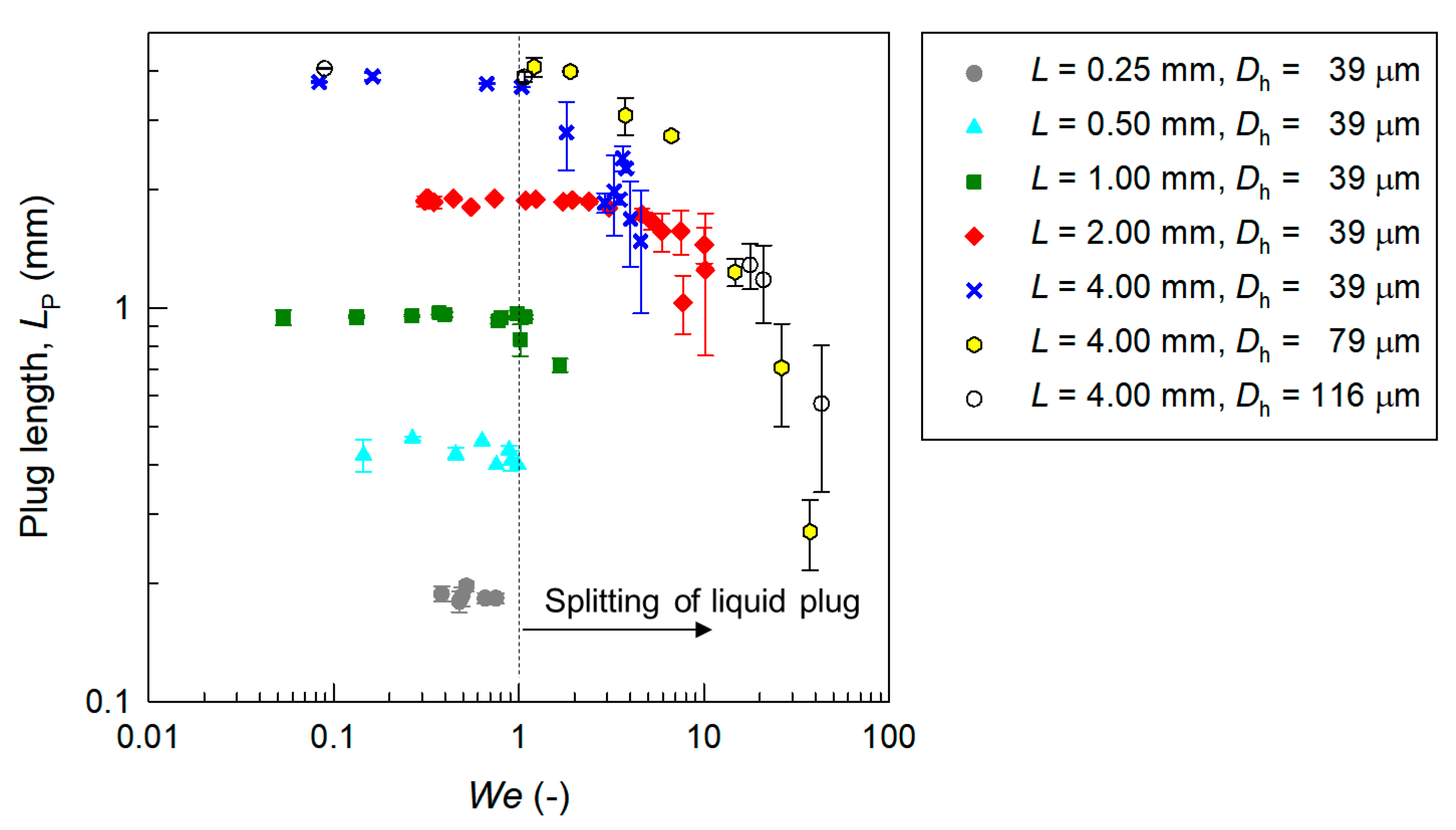
| Microchannel | Launcher Length, L | Width, W | Depth, D | Hydraulic Diameter, Dh |
|---|---|---|---|---|
| Channel 1 | 0.25 mm | 70 μm | 30 μm | 39 μm |
| Channel 2 | 0.50 mm | 70 μm | 30 μm | 39 μm |
| Channel 3 | 1.00 mm | 70 μm | 30 μm | 39 μm |
| Channel 4 | 2.00 mm | 70 μm | 30 μm | 39 μm |
| Channel 5 | 4.00 mm | 70 μm | 30 μm | 39 μm |
| Channel 6 | 4.00 mm | 140 μm | 60 μm | 79 μm |
| Channel 7 | 4.00 mm | 200 μm | 90 μm | 116 μm |
© 2018 by the authors. Licensee MDPI, Basel, Switzerland. This article is an open access article distributed under the terms and conditions of the Creative Commons Attribution (CC BY) license (http://creativecommons.org/licenses/by/4.0/).
Share and Cite
Kazoe, Y.; Matsuno, T.; Yamashiro, I.; Mawatari, K.; Kitamori, T. Transport of a Micro Liquid Plug in a Gas-Phase Flow in a Microchannel. Micromachines 2018, 9, 423. https://doi.org/10.3390/mi9090423
Kazoe Y, Matsuno T, Yamashiro I, Mawatari K, Kitamori T. Transport of a Micro Liquid Plug in a Gas-Phase Flow in a Microchannel. Micromachines. 2018; 9(9):423. https://doi.org/10.3390/mi9090423
Chicago/Turabian StyleKazoe, Yutaka, Takumi Matsuno, Ippei Yamashiro, Kazuma Mawatari, and Takehiko Kitamori. 2018. "Transport of a Micro Liquid Plug in a Gas-Phase Flow in a Microchannel" Micromachines 9, no. 9: 423. https://doi.org/10.3390/mi9090423






